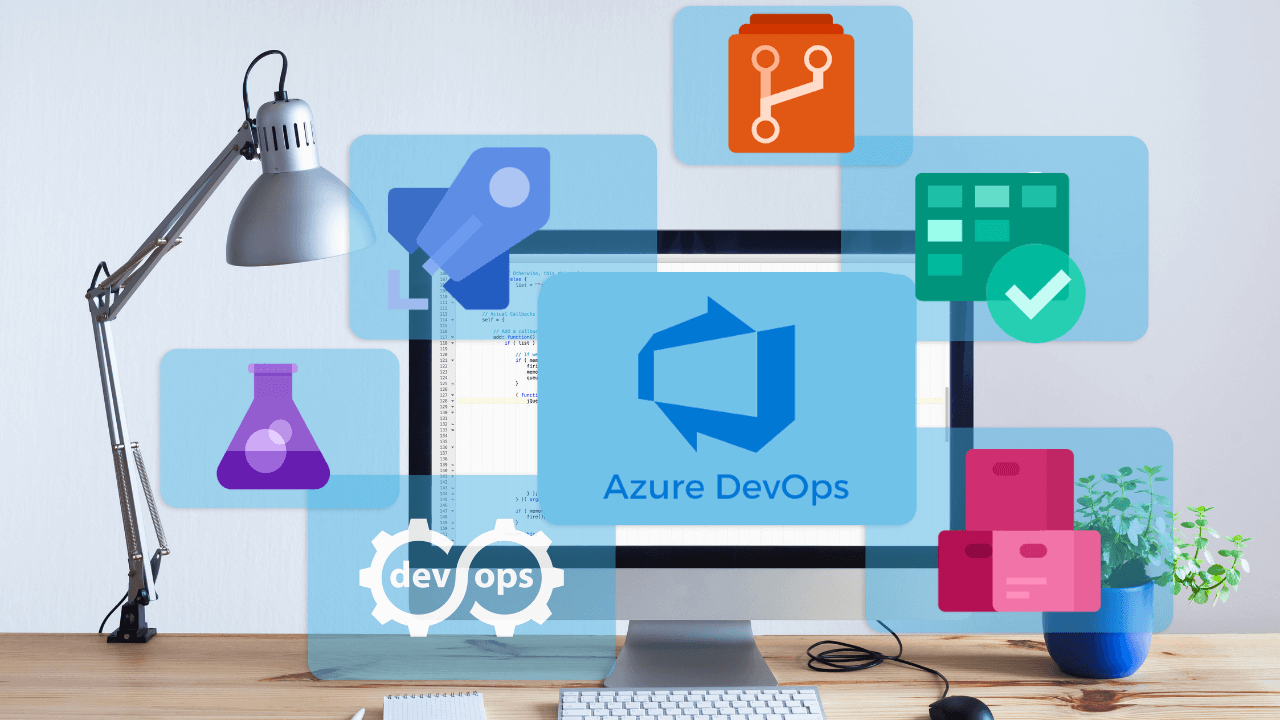Azure DevOps has emerged as a powerhouse in the realm of software development, providing an integrated platform for managing the entire software development lifecycle. Whether you’re embarking on a small-scale project or orchestrating a complex enterprise application, Azure DevOps offers a way to set your project development process up for success. In this article, we will walk you through the essential steps to get started with Azure DevOps, harness its capabilities, and propel your projects to success.
|
What is Azure DevOps?
Azure DevOps, a Microsoft product, stands as a user-friendly suite of development tools and services aimed at simplifying the complete software development lifecycle. This inclusive platform covers the whole DevOps journey and caters to the diverse needs of contemporary development teams. It guides teams through essential phases of the software development life cycle such as:
- Project planning
- Coding
- Automation
- Testing
- Release management
- Post-deployment monitoring
Having all these vital components be present in a synthesized environment allows Azure DevOps to simplify the intricacies of software development. It also boosts collaborative efforts among team members. Overall, Azure DevOps moves the organizational atmosphere towards a synergistic approach that promotes agility, efficiency, and fast delivery of high-quality software solutions.
The most notable feature of Azure DevOps is its user-friendly nature. This accessibility, coupled with the platform’s robust features, enables developers to execute tasks and deployment targets with high precision and speed.
What services does Azure DevOps offer? Understanding the Azure DevOps Ecosystem
Azure DevOps encapsulates a powerful group of services, all catering to different facets of the software development process. Familiarizing yourself with these services is critical to understanding Azure DevOps. Here are some of its core services:

Azure DevOps Ecosystem
Azure Boards
Your go-to agile project management tool that nurtures collaboration and project tracking within development teams.”
- Benefits: It acts as a central platform for project management. This enables efficient planning, tracking, and discussion across the entire development process. It also further bridges the discrepancies between diverse teams.
- Features: Customizable dashboards are included to view data easily. Modern agile tools like Kanbans are also included to drive productivity based on your team’s needs.
Azure Repos
Azure Repos is a version control system that helps teams manage their code through cross-collaboration and maintain code integrity.
- Benefits: Collaboration is enhanced due to the tools provided by the software.
- Features: Supports both Git and Team Foundation Version Control (TFVC) for any IDE, catering to different workflows. Maintains code quality with metrics like code reviewer sign-off, successful builds, and passing tests before pull requests.
Azure Pipelines
Azure Pipelines is an automated CI/CD service designed to ease software delivery by automating building, testing, and deployment processes.
- Benefits: The deployment processes become more efficient and error-free due to automated building, testing, and deployment of applications.
- Features: Continuous Integration (CI) and Continuous Delivery (CD) for automating building, testing, and deployment of applications.
Azure Test Plans
Azure Test Plans is a testing tool that allows teams to plan, track, and manage testing activities effectively.
- Benefits: Supports manual and automated testing, which enhances the traceability of issues. It also integrated with other Azure DevOps services to create a smooth testing experience.
- Features: Combines its features with various other testing tools and frameworks to allow manual, exploratory, and automated testing activities.
Azure Artifacts
Azure Artifacts is a package management system designed to simplify dependency management and software distribution.
- Benefits: Acts as a hub for managing packages, improving efficiency and reliability. These packages can then be shared by teams to ensure a level playing field.
- Features: Package hosting and package versioning features which enhance the user’s ability to share and distribute software more efficiently.
The following article may be of interest to you: What is DevOps and why is it important?
What are the key benefits of Azure DevOps?
Azure DevOps offers a range of benefits that contribute to an expedited, reliable development process. Some of the prominent advantages include:
Holistic platform
Azure DevOps provides an integrated platform that covers the entire DevOps lifecycle, from planning and coding to testing, releasing, and monitoring. Having all these facilities in one place reduces silos and enhances collaboration among development, operations, and quality assurance teams.
Agile Project Management
With Azure Boards, teams can embrace the concept of agile project management. Agile methodologies support features like work item tracking, backlog management, and sprint planning. This enables teams to iterate and respond to changes quickly, delivering value to users more frequently.
Version Control
Azure Repos supports both Git and Team Foundation Version Control (TFVC), offering a flexible version control system. Developers can efficiently manage and track changes to their code, which further preserves collaboration and code quality.
Continuous Integration and Continuous Delivery (CI/CD)
Azure Pipelines automates the building, testing, and deployment of applications, building a reliable and efficient CI/CD pipeline. This automation helps in reducing manual errors, accelerating the release process, and ensuring consistent quality.
Collaboration and Communication
Azure DevOps Services provide collaboration tools like pull requests, code reviews, and discussions, which motivates team members to continue effective communication amongst themselves. This collaboration leads to improved code quality and faster resolution times.
Package Management
Azure Artifacts enables teams to create, host, and share packages with their development and build processes. This consolidated package management system simplifies dependency management and enhances the consistency of builds and releases.
Flexibility and Extensibility
Azure DevOps is highly customizable, allowing teams to adapt the platform to their specific needs. It also supports a wide range of programming languages, platforms, and deployment targets, providing flexibility for a multitude of development projects.
Scalability
Azure DevOps can scale to accommodate projects of varying sizes, from small teams to large enterprises. The platform’s cloud-based nature ensures scalability, enabling it to handle the demands of projects, no matter the complexity.
Security and Compliance
Azure DevOps incorporates robust security features and compliance standards. It includes role-based access control and compliance with industry regulations, ensuring that projects adhere to security best practices.
Insights and Analytics
Azure DevOps offers analytics and reporting tools that provide insights into team performance, and progress. These metrics help teams make informed decisions regarding their projects, identify bottlenecks, and continuously improve their processes.
Onboarding to Azure DevOps
The journey into Azure DevOps begins with the creation of your Azure DevOps account. If you are yet to embark on this journey, let’s take you through the initial steps:
- Navigate to Azure DevOps Portal: Begin by visiting dev.azure.com, and click on “Start free.” Sign in or Create a Microsoft Account: Utilize an existing Microsoft account or create a new one, as per your preference.
- Create a New Organization: Organizations serve as containers for projects and teams. Choose a unique name for your organization.
- Initiate Your First Project: Once your organization is established, initiate a new project. A project is the nucleus where you manage source code, plan work, and monitor progress.
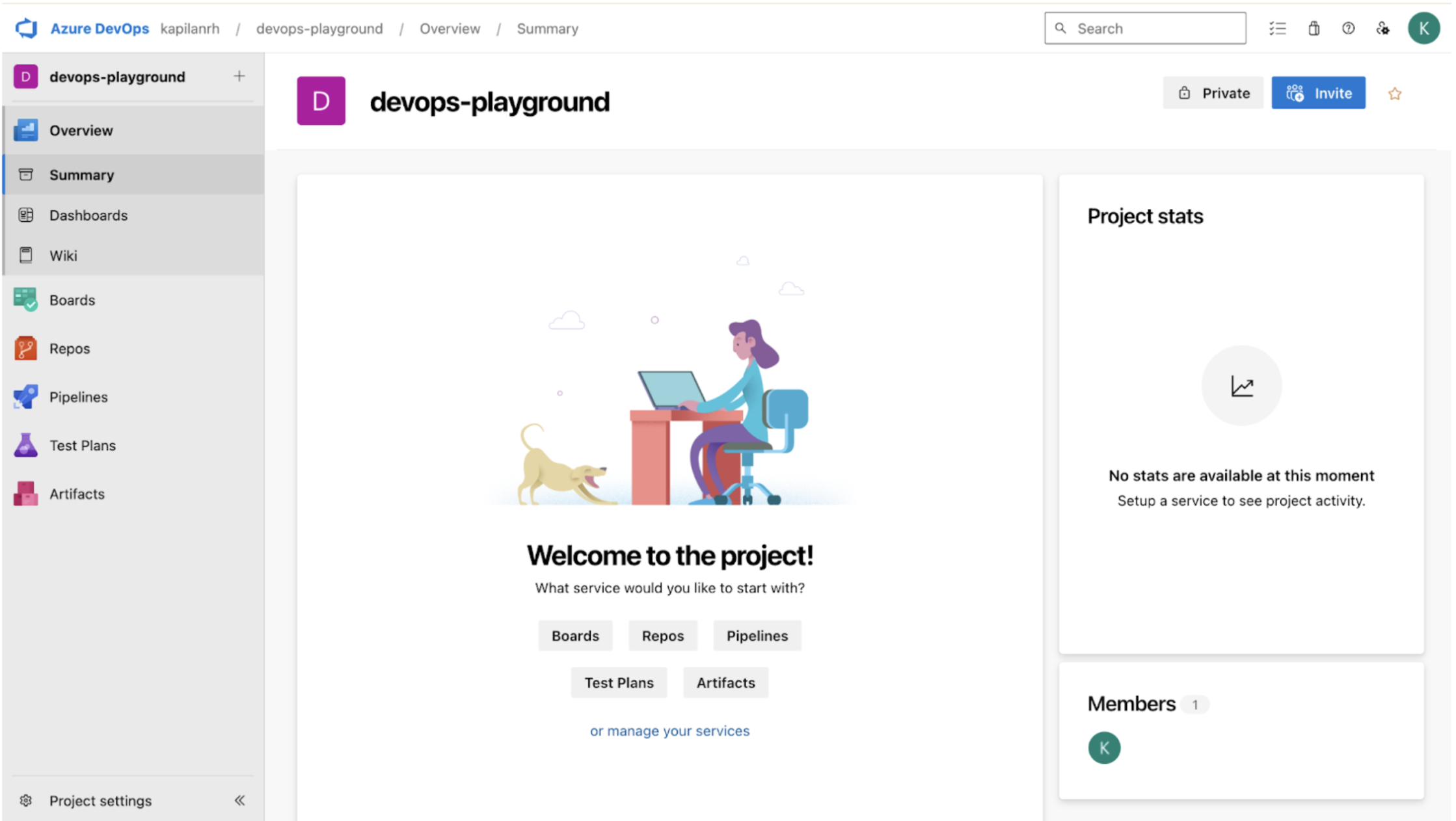
Azure DevOps account
Setting Up Azure Repos for Source Control
Azure Repos plays a pivotal role in version control, allowing you to store and manage your code effectively. Here’s how you can set up Azure Repos:
- Navigate to Repos: Inside your project, navigate to the “Repos” tab.
- Select Version Control System: Opt for Git, which is a modern, distributed version control system supported by Azure DevOps.
- Create a Repository: Click on “New repository” to create a new Git repository where your code will reside.
- Generate a personal access token for Azure Repos: Go to the Code section and select Full and Status permissions. This token will enable Retool to programmatically manage your repository, create pull requests, and view their statuses. Generate it using the correct admin in your organization.
- Tailor the Azure repository settings: Set your environment variables, and if they are correctly configured, your commits will reflect in the Deployment Dashboard.
- Clone the Repository: Clone the repository to your local machine using the provided URL, allowing collaboration and version control.
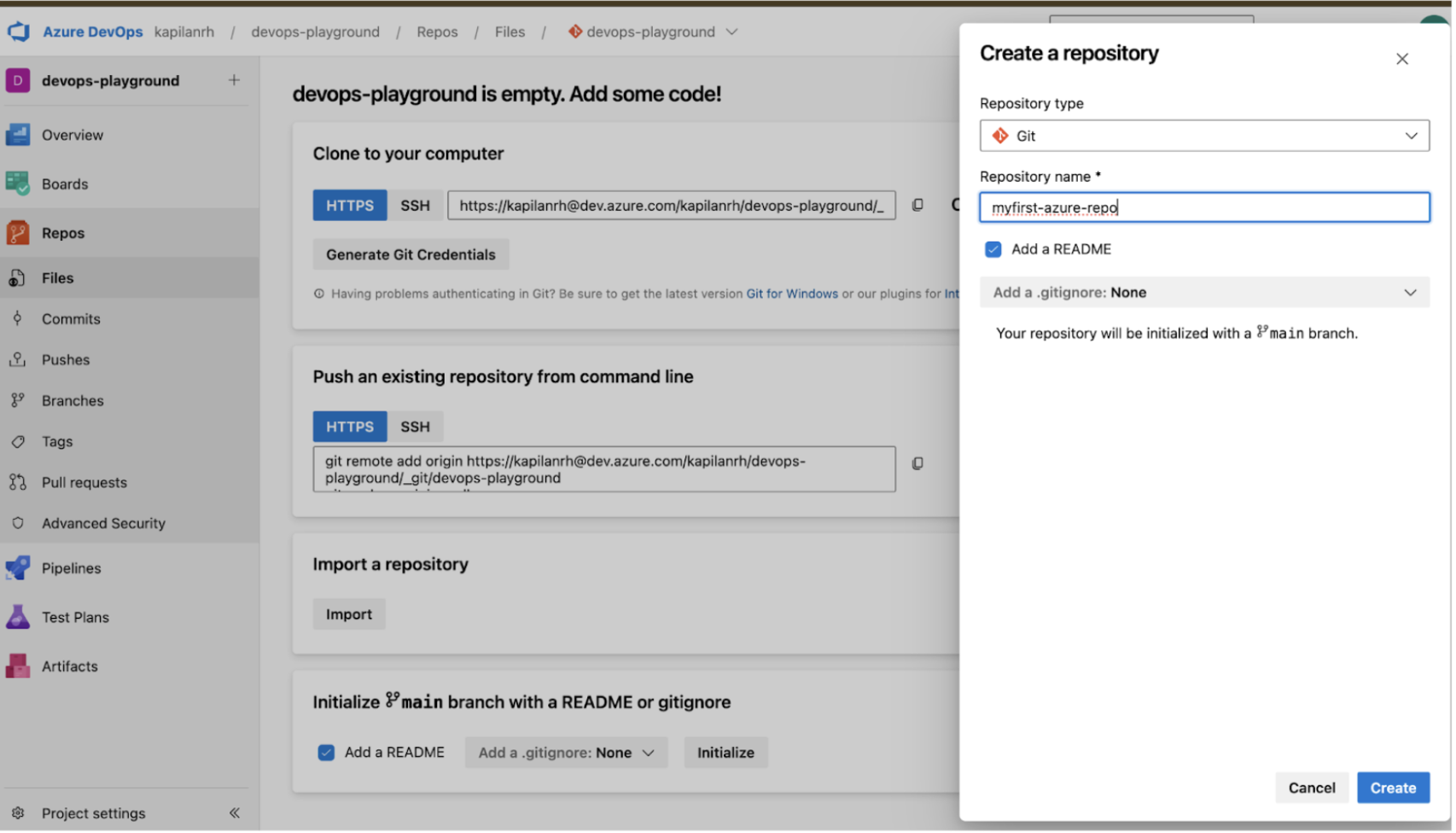
Setting Up Azure Repos for Source Control
Configuring Azure Pipelines for CI/CD
Azure Pipelines automates your build and release processes, ensuring a smooth transition from development to deployment.
Prerequisites
Once you set up the Azure DevOps account and repository, you can start creating the Azure CI/CD pipeline.
Steps to create an Azure CI/CD Pipeline
Here’s a step-by-step guide to configuring Azure Pipelines:
- Access Pipelines: In your project, head to the “Pipelines” tab.
- Initiate a New Pipeline: Click on “New pipeline” and select your repository, setting the stage for pipeline configuration.
- Choose a repository: Select the repository housing your application code. Select the suitable source control system, such as Git.
- Select a Template: Azure Pipelines offers various templates for common application types. Choose one aligning with your project.
- Customize the Pipeline: Tailor the pipeline configuration to meet your specific build and deployment requirements, incorporating necessary scripts and dependencies. Further gear the pipeline by defining build and test stages for code compilation, setting up deployment stages for target environments using Azure resources, configuring triggers for automatic pipeline initiation upon changes, and adding variables and secrets for storing configuration settings and sensitive information securely.
- Save, monitor, run, and iterate.
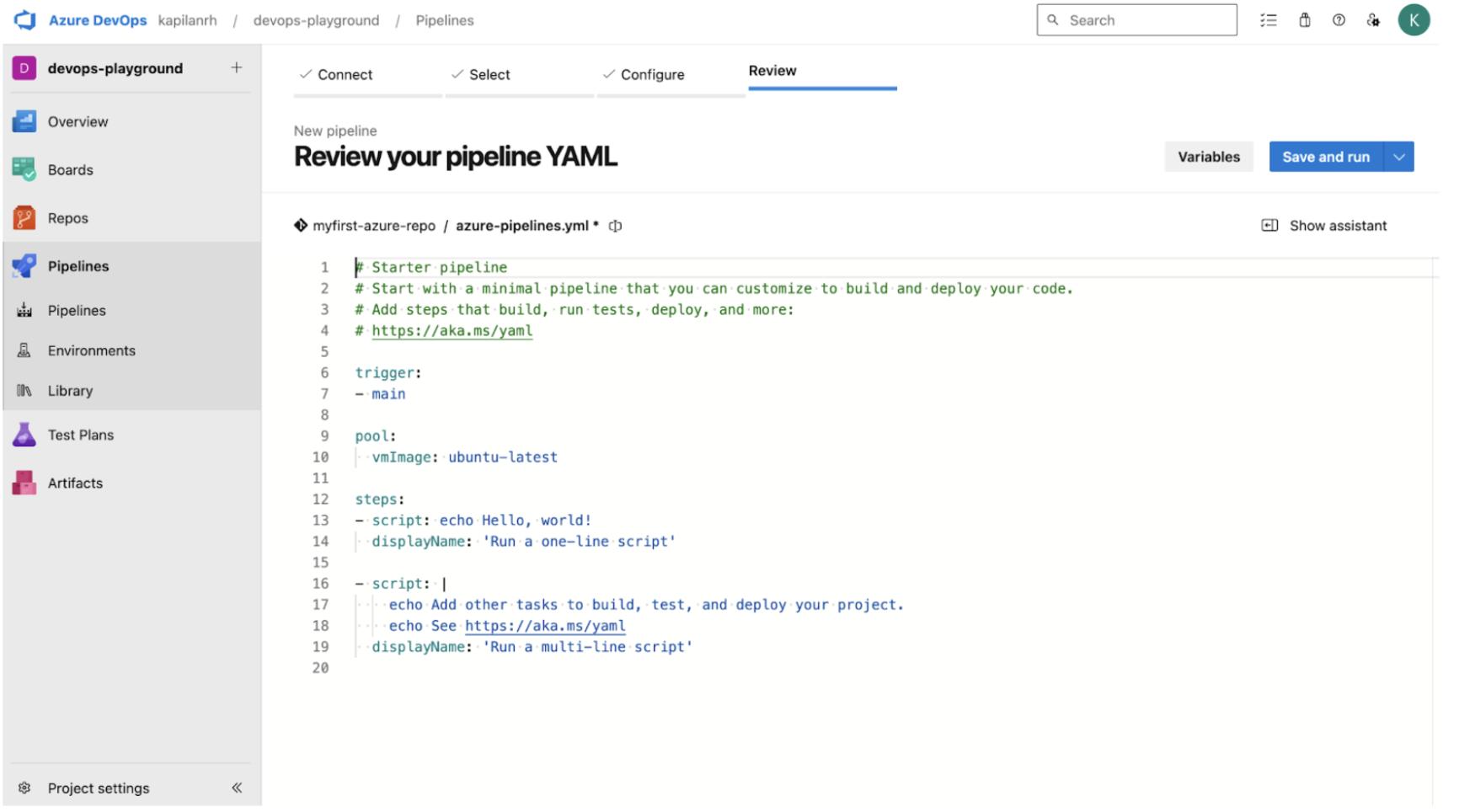
7. Save and Run the Pipeline: Save the pipeline configuration and trigger a manual run to validate the build and deployment processes.
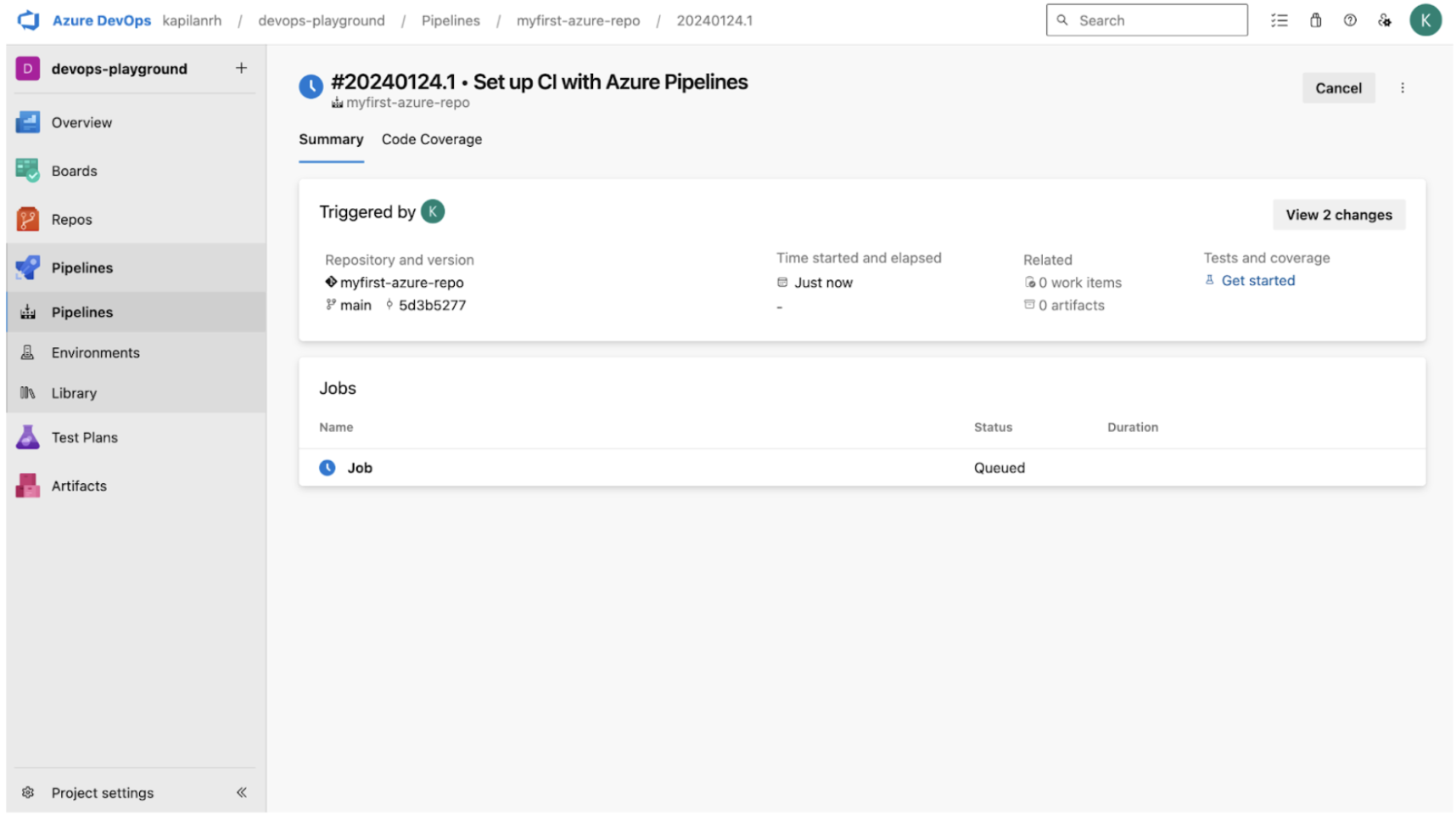
Agile Project Management with Azure Boards
Azure Boards serves as your companion in Agile project management, assisting in planning and tracking work. Here’s how to leverage Azure Boards effectively:
- Access Boards: Head to the “Boards” tab within your project.
- Initiate Work Items: Create work items representing tasks, features, or bugs. These work items form the backbone of your project management.
- Sprint Planning: Utilize Sprint planning tools to assign work items to sprints, facilitating efficient planning and tracking of progress.
- Customize Boards: Tailor boards to match your team’s workflow by adding custom columns, states, and work item types.
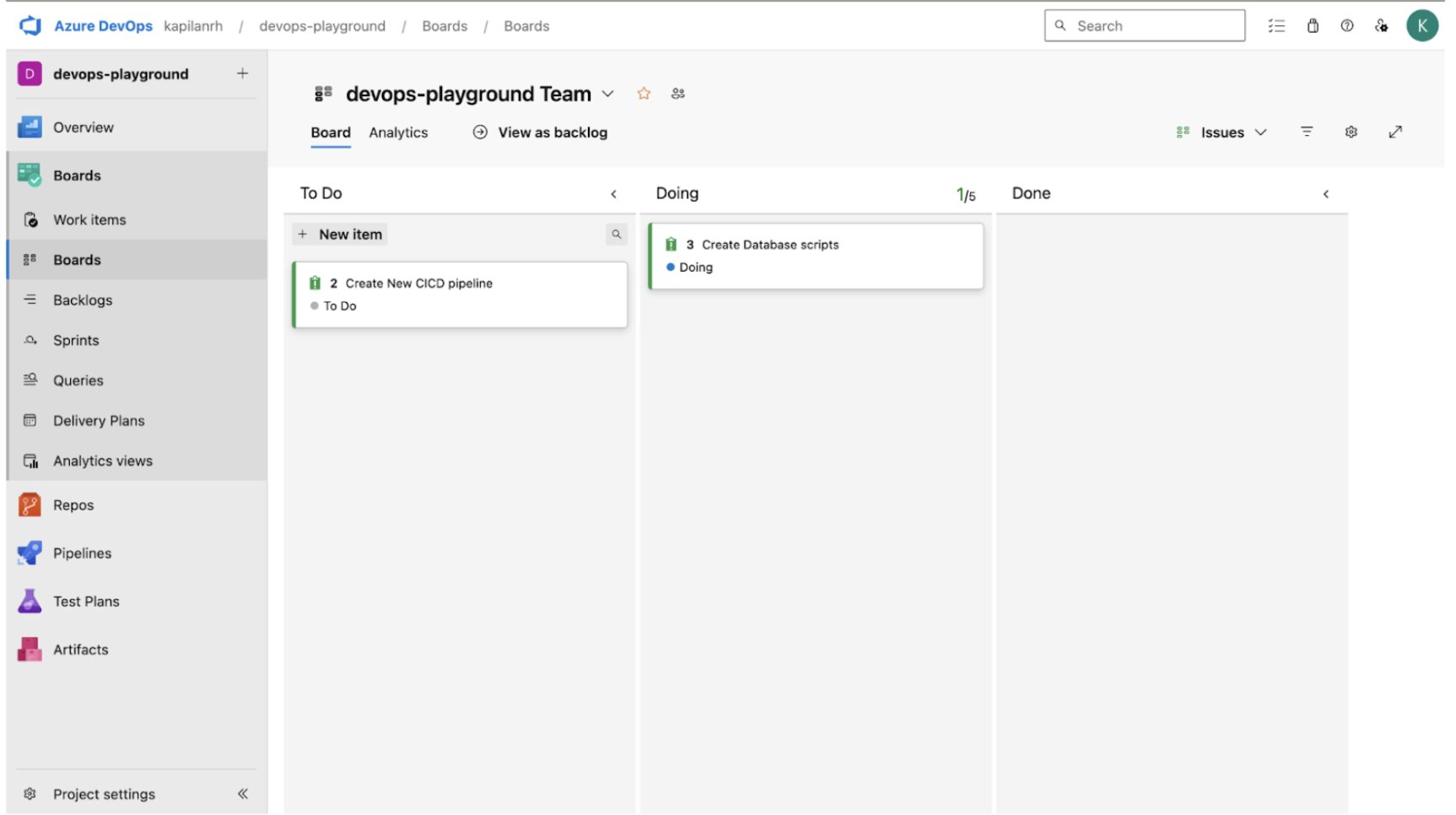
Agile Project Management with Azure Boards
Harnessing Azure Artifacts for Package Management
Azure Artifacts simplifies package management, streamlining the process of creating, hosting, and sharing packages within your team. Here’s how you can make the most of Azure Artifacts:
- Access Artifacts: Navigate to the “Artifacts” tab within your project.
- Create a Feed: A feed serves as a container for packages. Establish a new feed to host and manage your project’s packages.
- Publish Packages: Publish your project artifacts to the feed, making them readily available for consumption within your team.
- Manage Permissions: Implement robust access control to dictate who can publish and consume packages, ensuring a secure and organized package management system.
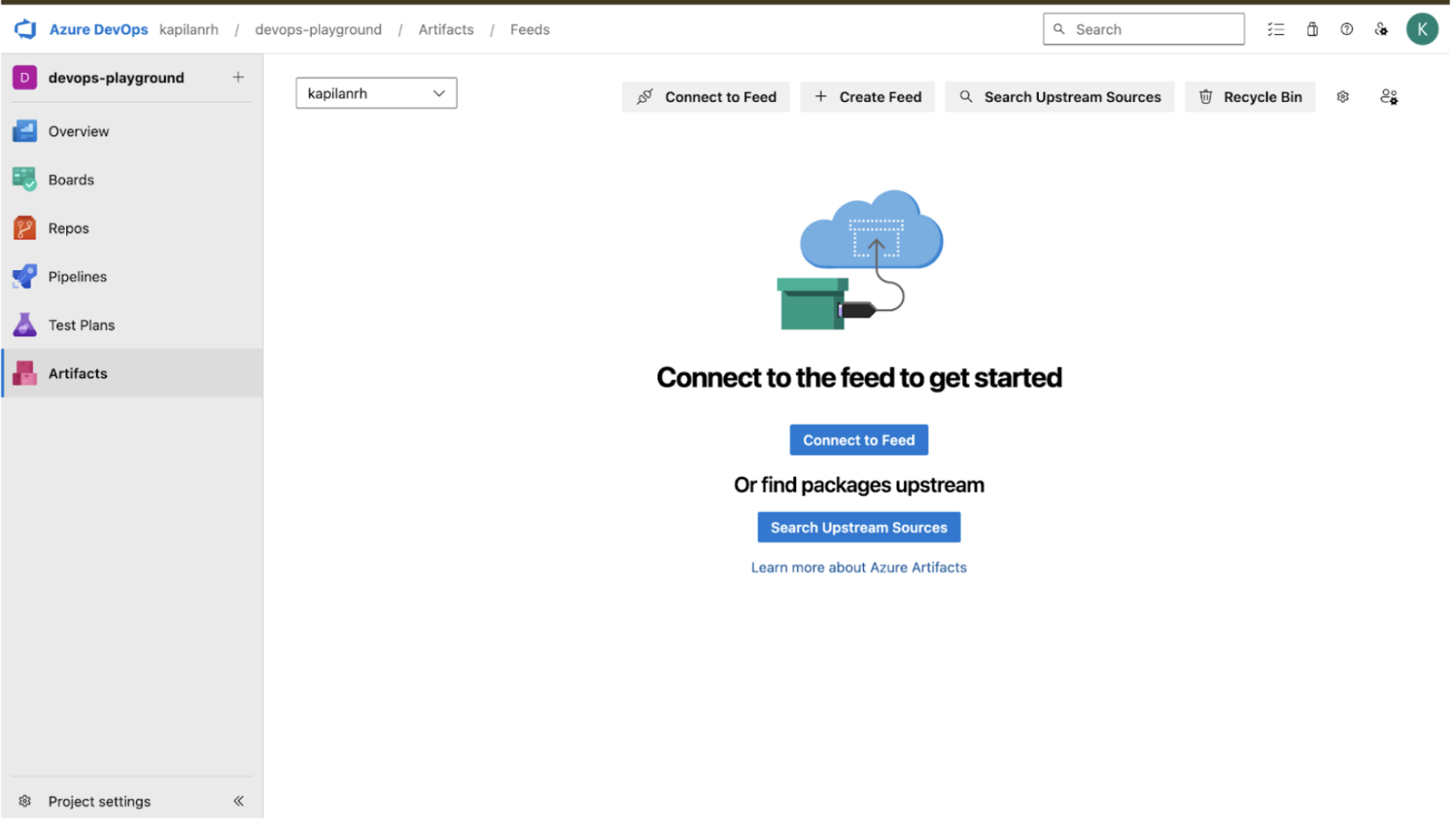
Harnessing Azure Artifacts for Package Management
Testing Excellence with Azure Test Plans
Ensuring the quality of your software is paramount, and Azure Test Plans provides the necessary tools for effective test management. Here’s a list of steps to incorporate testing into your Azure DevOps workflow:
Prerequisites
You must be a member of the Project Collection Administrators group. Organization owners are automatically members of this group.
Steps to create Azure Test Plans
Here’s a step-by-step guide to use Azure Test Plans:
- Access Test Plans: Navigate to the “Test Plans” tab within your project.
- Initiate a Test Plan: Define test plans to systematically organize and track your testing efforts, aligning them with project milestones.
- Create Test Cases: Develop detailed test cases that encompass various scenarios, ensuring thorough test coverage.
- Execute Tests: Execute tests manually or automate them using the integration with Azure Pipelines, ensuring the continuous validation of your software.
Azure DevOps: Use case
The diagram below offers an elaborate depiction of a scenario within Azure, showcasing a multi-tenant environment across multiple subscriptions. Each of these environments comprises numerous resource groups housing pivotal Azure components such as:
- API management
- Key Vault
- Application Insights
- Databases
- Service Bus
- Logic Apps
- Functions
From a DevOps perspective, the operational focus revolves around two primary deployment categories: platform deployment and configuration deployment:
- Platform deployment: It encompasses a series of actions including the execution of platform build scripts (leveraging tools such as Terraform or PowerShell), management of platform secret values, establishment of platform deployment pipelines, and the execution of platform health check tests.
- Configuration deployment: It entails the management of various configurations spanning APIs, Logic Apps, Service Bus instances, Functions Apps, and connectors. These configurations undergo deployment via an array of pipelines, each equipped with distinct test scripts meticulously tailored to specific business use cases developed by the team of developers. This approach ensures thorough validation and integration of configurations into the Azure environment.
Developer/DevOps engineers are responsible for crafting and refining source code, which is then committed to the Azure repository.
- Upon each commit, a pipeline specific to the corresponding branch and release version is triggered.
- Initially, the pipeline encompasses tasks such as code building, source code analysis, and security scanning to ensure code quality and security compliance.
- In the CI stage, further code analysis is conducted, secrets necessary for deployment are retrieved and managed securely, unit tests are executed to validate component functionality, and artifacts containing compiled code are created.
- Moving to the CD stage, the pipeline downloads the artifacts from CI, deploys them to the designated environment, and executes acceptance tests to verify application functionality.
This process is iterated across a range of scenarios, with each use case necessitating its own tailored Azure pipeline to handle the respective tasks efficiently

The following architectural diagram illustrates the CI/CD pipelines designed for the provisioning environments and deployment configurations.
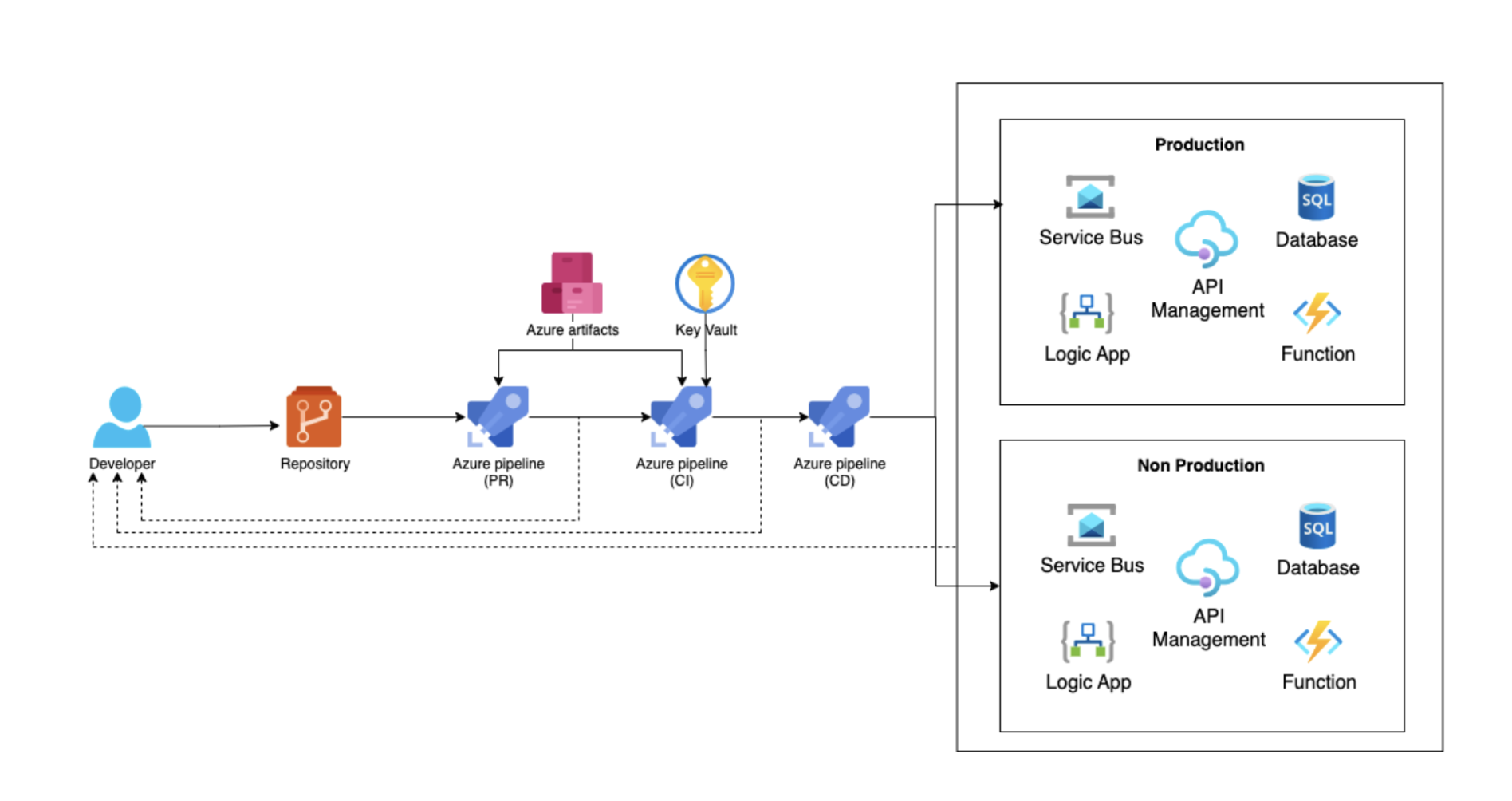
Architectural diagram that illustrates the CI/CD pipelines designed for the provisioning environments and deployment configurations.
The following article may be of interest to you: Azure vs AWS Integration: a comparison of the leading cloud solutions
Azure DevOps: Best practices
For Azure DevOps to ensure the success of your projects, it’s essential to adhere to best practices that promote efficiency, collaboration, and quality throughout the development process.
Continuous Integration and Continuous Deployment (CI/CD)
Implementing CI/CD pipelines is fundamental for automating the build, testing, and deployment of applications. Teams can optimize feedback loops and reduce manual errors by regularly integrating code changes and deploying them to production-like environments. In turn, features are delivered to customers more frequently.
Infrastructure as Code (IaC)
Tools like Azure Resource Manager (ARM) allow you to tap into the principle of Infrastructure as a Code. Users can rely on templates or Terraform to define and manage infrastructure configurations. This approach ensures consistency, repeatability, and version control of infrastructure deployments, enabling teams to automate infrastructure provisioning and scale applications.
Version Control
Robust version control systems such as Git can track changes to code, configurations, and infrastructure scripts. Branching strategies that facilitate collaboration, code review, and release management can also maintain the integrity and traceability of code changes over time.
Automated Testing
Implement automated testing practices, including unit tests, integration tests, and end-to-end tests, within CI/CD pipelines. Automated tests validate code functionality, identify regressions, and ensure application reliability and performance across different environments.
Security and Compliance
Security and compliance checks can be included into CI/CD pipelines to detect vulnerabilities, adhere to regulatory requirements, and enforce security standards. Leverage tools such as Azure Security Center, Azure Policy, and third-party security scanners to continuously monitor and thwart risks throughout the development lifecycle.
Monitoring and Logging
Integrate application monitoring and logging solutions like Azure Monitor and Application Insights to gain real-time visibility into application performance, usage, and other possible risks or issues. Monitor key metrics, set up alerts, and leverage telemetry data to identify and troubleshoot issues promptly.
Collaboration and Communication
Foster a culture of collaboration and communication within cross-functional teams by utilizing agile methodologies, kanban boards, and team dashboards available in Azure Boards. Encourage transparency, feedback, and knowledge sharing to continuously align the teams’ actions with common goals.
Conclusion
Advancing your DevOps journey can look like creating an account, setting up repositories, configuring pipelines, planning work with boards, managing packages with artifacts, and creating test plans. A toolkit such as Azure DevOps provides an integrated environment to help you with all that; the platform refines your development processes, enhances collaboration, and delivers high-quality software efficiently.
As you get started with Azure DevOps, you can explore advanced features and tailor the platform to suit the specific needs of your projects and teams. The platform’s ability to perfectly unify the process of planning, development, testing, and deployment positions Azure DevOps as a game changer in the software development space.
Are you an organization currently looking to smooth over your DevOps routine? Our team at Chakray specializes in the right solutions for your particular needs. We not only help you with the technology selection process, but also guide you through the implementation. Reach out to us today with your questions and we will provide you with the right answers.


Benefit from the advantages of infrastructure automation and DevOps practices in your business with Chakray's experience and advice
